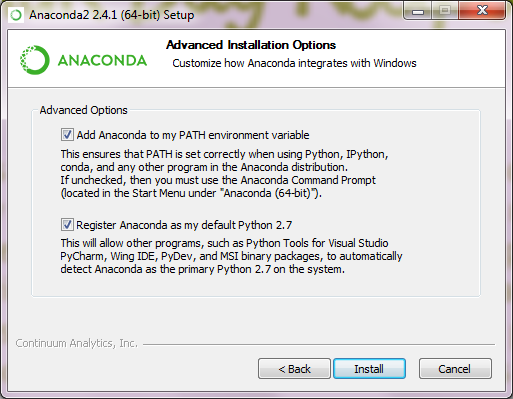How To Install Python Documentation
Posted : admin On 08.09.2019Install Python ¶ Being a Python Web. If you do either of the first two steps, keep an eye out for parts of the documentation marked new in development version. If you installed Django using pip or easy_install previously, installing with pip or easy_install again will automatically take care of the old version, so you don’t need to do it yourself. If you previously installed Django using python setup.py install, uninstalling is as simple as deleting the django directory from your Python site-packages.

Installing in Windows For Windows, or the more recent, is a prerequisite. The latter is installed automatically when you install PyInstaller using.
If necessary, follow the link to install it manually. It is particularly easy to use to install PyInstaller along with the correct version of. Also provides, which makes it simple to maintain multiple different Python interpreters and install packages such as PyInstaller in each of them. (For more on the uses of virtualenv, see below.) When pip-Win is working, enter this command in its Command field and click Run.
Installing from the archive If pip is not available, download the compressed archive from. If you are asked to test a problem using the latest development code, download the compressed archive from the develop branch of page. Expand the archive. Inside is a script named setup.py. Execute python setup.py install with administrator privilege to install or upgrade PyInstaller. For platforms other than Windows, Linux and Mac OS, you must first build a bootloader program for your platform: see. After the bootloader has been created, use python setup.py install with administrator privileges to complete the installation.
Pyinstaller -version The result should resemble 3.n for a released version, and 3.n.dev0-xxxxxx for a development branch. Watch movie logan online 720p. If the command is not found, make sure the execution path includes the proper directory:.
Windows: C: PythonXY Scripts where XY stands for the major and minor Python version number, for example C: Python34 Scripts for Python 3.4). Linux: /usr/bin/. OS X (using the default Apple-supplied Python) /usr/bin.
OS X (using Python installed by homebrew) /usr/local/bin. OS X (using Python installed by macports) /opt/local/bin To display the current path in Windows the command is echo%path% and in other systems, echo $PATH. Installed commands The complete installation places these commands on the execution path:.
Beginner's Guide
pyinstaller is the main command to build a bundled application. pyi-makespec is used to create a spec file. pyi-archiveviewer is used to inspect a bundled application.
pyi-bindepend is used to display dependencies of an executable. pyi-grabversion is used to extract a version resource from a Windows executable. If you do not perform a complete installation (installing via pip or executing setup.py), these commands will not be installed as commands. However, you can still execute all the functions documented below by running Python scripts found in the distribution folder. The equivalent of the pyinstaller command is pyinstaller-folder /pyinstaller.py. The other commands are found in pyinstaller-folder /cliutils/ with meaningful names ( makespec.py, etc.).

Note Currently, Python offers two major versions, 2.x and 3.x. Sphinx 1.5 can run under Python 2.7, 3.4, 3.5, 3.6, with the recommended version being 2.7.

How To Install Python On Windows 7
This chapter assumes you have installed Python 2.7. Follow the Windows installer for Python. After installation, you better add the Python executable directories to the environment variable PATH in order to run Python and package commands such as sphinx-build easily from the Command Prompt. Right-click the “My Computer” icon and choose “Properties”.
Click the “Environment Variables” button under the “Advanced” tab. If “Path” (or “PATH”) is already an entry in the “System variables” list, edit it. If it is not present, add a new variable called “PATH”.
Docs
Add these paths, separating entries by “;”:. C: Python27 – this folder contains the main Python executable. C: Python27 Scripts – this folder will contain executables added by Python packages installed with pip (see below) This is for Python 2.7. If you use another version of Python or installed to a non-default location, change the digits “27” accordingly.
Now run the Command Prompt. After command prompt window appear, type python and Enter. If the Python installation was successful, the installed Python version is printed, and you are greeted by the prompt. Type Ctrl+Z and Enter to quit.